 The Biking Life
The Biking Life
by: Naomi Bloom 7/1/2005
Sag Wagon Tales
Longer ago than I care to calculate, I wrote an article titled "Tales from the Sag Wagon" for now-defunct California Bicyclist magazine. With century season in full swing, I've been reminded of this topic more than once. So I figure it's time to revisit the subject.
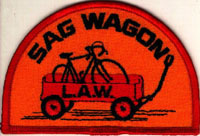 The sag is the rider's lifeline out on the road. It's the insurance policy you get when you sign up for an "organized" ride. That ride might be a century, a charity event, a multi-day tour -- you name it. You may be surrounded by hundreds, even thousands, of fellow cyclists. But when your tire is flat (and your patch glue has dried up) or you smack a face plant on the hard, hot pavement, it's the motor vehicle -- and the folks inside it -- that will save your hide.
The sag is the rider's lifeline out on the road. It's the insurance policy you get when you sign up for an "organized" ride. That ride might be a century, a charity event, a multi-day tour -- you name it. You may be surrounded by hundreds, even thousands, of fellow cyclists. But when your tire is flat (and your patch glue has dried up) or you smack a face plant on the hard, hot pavement, it's the motor vehicle -- and the folks inside it -- that will save your hide.
That said, it's also true that the sag driver is most often the one to witness the sometimes crazy, often idiotic things that happen.
So what does it mean?
Exactly what is a sag wagon, and how did it get that name?According to Sheldon Harris's online glossary, it's "a car or truck that picks up or otherwise assists riders who have had to stop riding, either due to fatigue, injury, or mechanical failure. This is primarily a touring term, racers call the corresponding vehicle the 'broom wagon.'"
"Some people," Harris adds, "believe that the term derives from the verb 'sag,' others maintain that it is an acronym for 'Support And Gear.'"
The term is just quirky enough to attract attention from a professional lexicographer. If, like me, you're into that sort of thing, check out Grant Barrett's etymology.
In an open letter to ride directors, John Sadowski of Richardson, TX, points out: "Sag wagons do not have to be a pickup truck. What you want is to provide a presence all along the route. Itty bitty little cars with a big sign can be VERY reassuring to a tired rider. Of course, the little car can not pick you up but it can carry a cooler of ice water and the driver can drive back to the rest stop for help (or use a cell phone)."
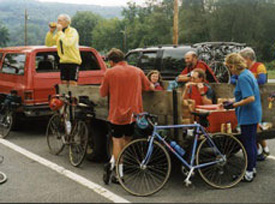
Sags of the century
My collection of sag tales began in the early 1980s, when Skyline Cycling Club held its first metric century, the Prince Charming Classic. (Registration was limited to men only, in response to the venerable Cinderella Classic.) The first thing I discovered about the job was that it involved long stretches of numbing boredom, broken by a few flashes of adrenalin-pumping excitement.First was the guy who took a dive directly off the downhill side of Mt. Eden Road. Now Mt. Eden, although it can be tricky, is not exactly the equivalent of a Tour de France alpine descent. And it's really hard to find an edge to drop off from. This fellow was able to drag his bike back up the side of the hill and discover me rounding the switchback. His ride, however, was over. "I don't know how it happened," he confessed. "I've ridden this road countless times before. I guess I just lost it."
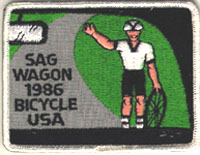
About two hours later two guys standing beside a tandem flagged me down. Both were unscathed, but the bike captain's crankset was totaled. Could I drive them back to the start? I turned to the stoker for help getting the tandem on my (fortunately long) rack. He was totally blind. I'd never before heard of tandem captains volunteering to steer blind stokers around. It was a heartwarming experience.
Last year, my opposite number Bill Oetinger did sag duty for the Marin Century. According to his December article his first customer had actually gone through a barbed-wire fence into a pasture. Once the paramedics finished wrapping him in gauze, "he looked more like a mummy than a cyclist."
I've since given up driving sags in favor of slicing and dicing food at rest stops. So I can attest that sag drivers don't get all the off-the-wall action on centuries. Last year on the Tierra Bella a sweet young thing approached me breathlessly. "Does anyone have any disinfectant I can use on my glove? I dropped it in the portapotty but I got it out! But now I don't want to wear it like this."
Sags on tour
The vast majority of multi-day tours, whether with high-end outfitters like Backroads or with your hometown club, have sags. But note that there are at least three different styles of tour sagging, depending on level of service.Your basic tour sag simply carries your luggage to your next overnight stay. With the luxury end of this service, you'll arrive to find your bags in your room or your tent pitched and your pack inside. But most simply dump everything in a pile for you to sort out at the end of a long day in the saddle.
A more solicitous type of sag will shoot ahead of the group to deliver luggage, then double back to make sure everyone is still pedaling with the rubber side down. The driver will pick up anyone begging for a ride and ferry them to either the front of the pack or the final destination.
The third type doesn't take off for the destination until the last riders have left, then leapfrogs to a designated rest stop to offer refreshments "from the back of the sag." Indeed, some of the high-end tour outfitters put on a veritable feast for both lunch and snacks.

Of course, if you're planning your own tour, you can mix up these types of sag support to suit yourselves. Or you can just luck out with your choice of drivers. In 2001 we requested no more than basic service from our volunteer drivers on our tour in Southern France. But these non-cycling spouses hated to miss out on what the rest of us were up to. They followed us for most of the route and took the same chateau and cave tours we did. Yet they still found time to deliver our bags to our rooms, and to have an adventure or two of their own.
One of the best sags I ever witnessed was on Cycle Oregon in the early 90s. This was back when the big white bus that sagged for the original SuperTour every summer, then chugged up to Oregon to support SuperTour riders doing the cross-state ride. That bus lugged tents, duffles and humongous amounts of food from campground to campground, picking up any CO rider who needed a lift along the way.
On some big cross-state rides, the sag may not even be a motor vehicle. One RAGBRAI story described "a train for those tired of riding bikes. The only problem was that it did not go to the next town!"
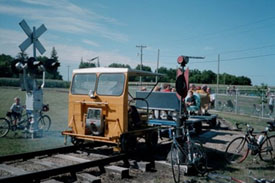
Sag rules of the road
Herewith a few sag etiquette guidelines:Riders, even if you don't think you'll ever need a sag, be sure you know how to flag one down. Most tour leaders provide a cell phone number to call. Others expect you to signal the driver. A simple smile and a wave don't look urgent. One solution is to tap your helmet on your head a few times.
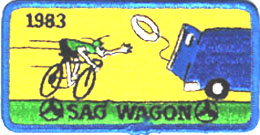
But please, don't depend on the sag to be your personal taxi service. Bill recalled a guy who had a plane to catch and had run out of time. There were two ladies who simply wanted to be chauffeured to the top of the next hill -- bad form on a century. Remember Mr. Mummy and the many others who might be suffering in pain while waiting for your "limo" to return to its original purpose.
Personal sags are another no-no. There is enough traffic already on the road. Your personal sag just adds to it, making the ride even more hazardous.
As for drivers, says Texan Sadowski, "it is considered very uncouth to follow a rider in a sag wagon . . . .it points out 'Hey! This jerk is the last rider,'" and makes him vulnerable to the pickup behind who can't see around the sag. When it passes, it could pull in quickly, right where the rider is.
In fact, the driver should be aware of all the conditions around his sag and the riders. Know the route you're driving well enough to predict where riders might encounter hazards. Tune in to the traffic situation, the weather and environment. Jim forgot to when he was sagging a tour in Provence. He followed the riders up Mont Ventoux and stepped out of the van. In less time than it takes to say "ventoux," (French for "windy"), his favorite chapeau had sailed hundreds of meters down the mountain. "Someone in the Provencal town of Orange," says Jim, "has a really nice beret."
Naomi can be reached at naomibloom@earthlink.net
